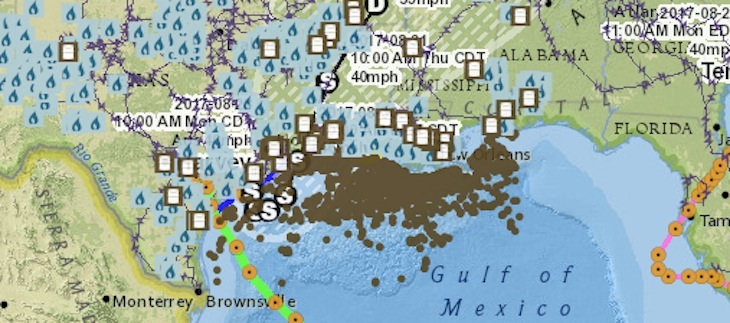‘Brief but dramatic’ higher pump prices expected from Harvey fallout
by August 28, 2017 3:24 pm 666 views

Segment of the Energy Information Administration map showing energy industry impacts from Hurricane Harvey.
As severe flooding from Hurricane Harvey inundates much of the nation’s gasoline refining infrastructure on the U.S. Gulf Coast, Arkansas motorists should expect to see a spike in pump prices over the next several weeks, AAA officials are warning.
According to the U.S. Energy Information Administration, flooding and high winds caused by Hurricane Harvey have the potential to affect energy infrastructure in the region, including the Texas Gulf Coast, home to a great deal of oil and natural gas infrastructure.
The U.S. Gulf of Mexico accounts for nearly 20% of total U.S. crude oil production and the Texas Gulf Coast is home to nearly one-third of U.S. refining capacity. As of late last week, several oil companies had already shut down production from nearly a dozen facilities and had evacuated personnel from offshore platforms.
In its weekly forecast on Friday (Aug. 25), AAA said Hurricane Harvey had the potential to negatively affect five southern Texas coast refineries and condensate splitters, as well as crude and gasoline inventory levels in the region and beyond.
“A hurricane like this typically causes an increase in fuel purchases in the market and a slowdown in retail demand,” said Jeanette Casselano, AAA spokesperson. “Spikes in pump prices due to the effects of hurricanes tend to be brief but dramatic.”
Before Hurricane Harvey hit last week, more than 10 refineries in the Houston and Corpus Christi, Texas, area had closed ahead of the category 4 storm. Over the weekend, refinery operators in Corpus Christi, which is home to five refineries and splitters, were already assessing the area for damages and any disruptions in the region’s gasoline infrastructure that account for 4.2% of total U.S. oil refining capacity.
Since 2013, the EIA has tracked major storms and energy disruptions with interactive maps that combine real-time data feeds from the National Hurricane Center with more than 20 map layers showing the nation’s energy infrastructure and resources. The tool allows industry, energy analysts, government decision makers, and the public to better see and understand the potential impact of a storm.
Valero Corp., the nation’s largest refinery operator, said Monday its two Corpus Christi facility and its nearby Three Rivers, Texas, refinery did not have substantial refinery impacts resulting from the storm.
“We are working closely with local, state and federal agencies as well as our business partners to evaluate infrastructure needed to resume refinery operations, in particular, port operations,” the Texas refinery giant said.
The Houston, Texas City and Baytown region, where flooding reached historic levels, is home to 11 refineries that in total represent 14% of U.S. processing capacity. A forecast of heavy rainfall leading to potential flooding and power outages is expected. According to AAA, Harvey’s largest impact is likely to be significant reduction of crude imports into the Gulf Coast, affecting refineries’ crude production rates. Imports to Mexico could also be impacted, and there could be an unexpected rise in gasoline exports from other regions in the U.S to meet any challenges faced in the area under watch in Mexico.
Also, the Florida market could take a hit as tanker ships may not be able to travel across the Gulf of Mexico.
Hurricanes Gustav and Ike in 2008 and Hurricane Isaac in 2012 were the most recent hurricanes to make landfall on the U.S. Gulf Coast, with Ike being the last hurricane to directly affect Texas, according to the EIA. All three storms affected oil and natural gas infrastructure in the region, each shutting in more than one million barrels per day of crude oil production and more than three billion cubic feet per day of natural gas production and temporarily shutting down significant pipeline and refining capacity.
In Arkansas, gas prices were holding steady on Monday, averaging nearly $2.12 per gallon across the state. That price is one penny higher than a week ago and six cents more expensive than a year ago, according to AAA’s daily fuel gauge.
